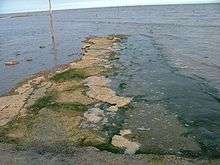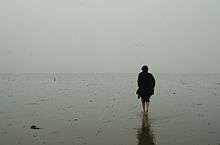The Broomway


The Broomway is a public right of way (specifically a Byway Open to All Traffic) over the foreshore at Maplin Sands off the coast of Essex, England. When the tide is out, it provides access to Foulness Island, and indeed was the only access to Foulness Island on foot until a road bridge was built over Havengore Creek in 1922.[1]
The Broomway runs for 6 miles (9.7 km) along the Maplin Sands, some 440 yards (400 m) from the present shoreline. Six headways run from the track to the shore, giving access to local farms. The track is extremely dangerous in misty weather, as the incoming tide floods across the sands at high speed, and the water forms whirlpools because of flows from the River Crouch and River Roach. Under such conditions, the direction of the shore cannot be determined. After the road bridge was opened in 1922, the Broomway ceased to be used, except by the military.[2]
Notoriety
Often compared to the similarly dangerous path across Morecambe Bay, the Broomway has long been notorious as "the most perilous byway in England".[3] It has earned this reputation by virtue of the disorienting nature of its environment in poor visibility, and near inevitability of death by drowning for anyone still out on the sands when the tide comes in.[4] Many people have died on it over the years.[5] The Foulness Burial Register records 66 bodies recovered from the sands since 1600 which is only a fraction of the total who have drowned.[6]
Navigation and access
The Broomway leaves the mainland at Wakering Stairs, where there is a causeway over the band of soft mud (known as the Black Grounds)[7] which separates the mainland from the firmer ground of the Maplin Sands. Once upon the Maplin Sands, the Broomway heads approximately 60 degrees (magnetic) towards a navigation beacon known as "the Maypole". This beacon marks the entrance to Havengore Creek. From the Maypole the road takes a more northerly route of approximately 50 degrees (magnetic) to the causeway leading to Asplins Head, the first of the surviving highways onto Foulness Island. From Wakering Stairs to Asplins Head is a walk of about one hour. The Broomway was formerly marked by a series of markers resembling brooms (hence its name),[8] but it is now largely unmarked. There is no actual track, and for the majority of its six-mile route the Broomway is nothing more than a compass bearing over Maplin Sands.[9]
Access to the Broomway is restricted because both the mainland at Wakering Stairs and Foulness Island itself are given over to military purposes.[10]
References
- ↑ Fautley, Matthew and James Garon (2005). The Essex Coastline: Then and Now, p.193. Potton Publishing, Winterbourne Down. ISBN 0954801008.
- ↑ Smith, J. R. (1970). Foulness, A History of an Essex Island Parish. Essex County Council Record Office. p. 41. ISBN 90-03-60097-X.
- ↑ King, Tom. "Exploring the truth behind island's deadly footpath" Echo, Southend-on-Sea, 9 September 2006. Retrieved on 2 February 2013.
- ↑ Macfarlane, Robert (2012). The Old Ways, p. 65. Penguin Books, London. ISBN 9780241143810.
- ↑ Macfarlane, Robert (2012). The Old Ways, p. 64. Penguin Books, London. ISBN 9780241143810.
- ↑ Arnold, Patrick (2013) The Broomway ISBN 978-0-9516313-3-1
- ↑ Map of the Essex coast near Wakering Stairs showing the "Black Grounds" Streetmap.co.uk
- ↑ King, Tom. "Exploring the truth behind island's deadly footpath" Echo, Southend-on-Sea, 9 September 2006. Retrieved on 2 February 2013.
- ↑ Macfarlane, Robert (2012). The Old Ways, p. 73. Penguin Books, London. ISBN 9780241143810.
- ↑ INFORMATION FOR PEOPLE WISHING TO USE THE BROOMWAY, published by the UK Ministry of Defence's site managers, QinetiQ.
External links
- Interview with author Robert Macfarlane, whose 2012 book The Old Ways contains a detailed description of a Broomway walk on PRI/BBC collaboration The World
- Safety and other information for walkers on the Broomway
- Route as shown on google maps
